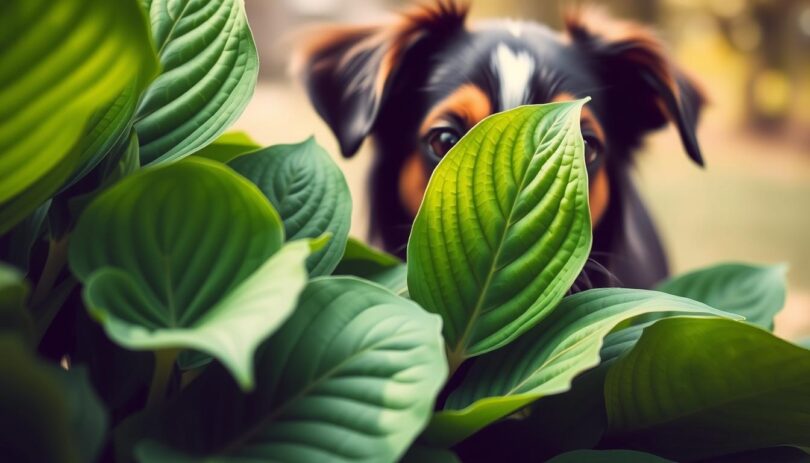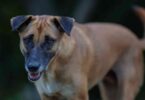Over 200,000 cases of pet poisoning involving household plants are reported annually in the U.S., according to the ASPCA. Among these incidents, leafy garden favorites like hostas often play a surprising role. While their lush foliage brightens shady yards, these plants contain saponins—natural compounds that can harm curious pets.
This guide breaks down what every dog owner should understand about hostas and their risks. You’ll learn how toxicity levels vary, recognize early symptoms of exposure, and discover practical steps to protect your furry companion. Veterinary insights and real-world scenarios help clarify when to seek professional care.
Topics covered include:
- How saponins affect canine health
- Common signs of plant-related illness
- Immediate response strategies for suspected poisoning
- Pet-safe landscaping alternatives
With 67% of gardeners unaware of common toxic plants, education becomes vital for prevention. By combining expert advice with actionable tips, this resource empowers you to create safer outdoor spaces. Knowledge transforms worry into confident pet parenting—let’s explore how.
Understanding the Toxicity of Hostas
Many gardeners love these leafy perennials for their ability to thrive in shaded areas, but their beauty hides hidden risks. The danger comes from natural chemicals called saponins, which act as the plant’s defense system. These compounds irritate a dog’s digestive tract when ingested, causing discomfort and potential health complications.
Key Toxic Compounds: Saponins Explained
Saponins create a soap-like foam when mixed with water, explaining their name from the Latin “sapo” (soap). In dogs, these chemicals disrupt cell membranes in the stomach and intestines. Mild exposure typically causes vomiting or diarrhea, while larger amounts may lead to lethargy or appetite loss.
High-Risk Plant Components
Leaves and stems contain the highest saponin concentrations, making them the most hazardous parts. Though flowers hold smaller amounts, curious pets might still nibble them during exploration. Young, tender leaves prove particularly problematic due to their appealing texture and easier chewability.
Shaded garden spots where these plants flourish often become unsupervised play zones. Pet owners should regularly check these areas for bite marks or disturbed soil. Early detection of chewing behavior helps prevent serious incidents before they escalate.
Are Hostas Poisonous to Dogs?
When pets explore gardens, their curiosity can lead to unexpected dangers. Recognizing early warning signs helps owners act swiftly to protect their companions. Symptoms often appear within hours of exposure, requiring immediate attention.
Recognizing Symptoms of Plant Poisoning
Initial indicators focus on digestive distress. A pet might vomit repeatedly or experience watery diarrhea. Loss of appetite and excessive drooling often accompany these reactions, signaling mouth irritation from toxic compounds.
Gastrointestinal and Neurological Effects
Severe cases escalate beyond stomach issues. Watch for abdominal pain—your dog might whine when touched or adopt a hunched posture. Neurological impacts include muscle tremors, unsteady movements, or rare seizures. Lethargy lasting more than 24 hours warrants urgent veterinary evaluation.
Owners should note behavior changes like sudden hiding or agitation. These subtle shifts often precede visible physical symptoms. Quick action improves outcomes, so contact a vet if multiple signs develop simultaneously.
How Dogs Get Exposed to Toxic Hostas
Gardens brim with intriguing textures and scents that captivate curious pets. While exploring flower beds, many canines encounter hazards disguised as harmless greenery. Recognizing common exposure scenarios helps owners minimize risks while maintaining vibrant outdoor spaces.
Accidental Ingestion and Risk Behavior
Young pups and energetic breeds often investigate plants through chewing or digging. Playful nibbling escalates quickly when unsupervised pets discover fallen leaves or broken stems. Even small amounts ingested during brief outdoor sessions can trigger digestive distress.
What Draws Pets to Hostas in the Garden
The plant’s broad, floppy leaves sway enticingly in breezes, stimulating a pet’s hunting instincts. Earthy scents from crushed foliage further attract sniffing and mouthing behaviors. Tender new growth proves particularly tempting due to its soft texture and moisture content.
High-risk situations include:
- Unfenced garden areas accessible during play
- Freshly trimmed leaves left on the ground
- Containers placed at nose level
Regularly inspect shaded corners where these perennials thrive. Redirect chewing urges by providing safe chew toys in outdoor spaces. Immediate cleanup after gardening prevents accidental snacking that could lead to vomiting or diarrhea.
Identifying Signs and When to Act
Swift action following the first signs of illness protects your dog’s well-being. Immediate recognition of distress signals allows owners to intervene before complications escalate. Three key indicators demand attention: digestive upset, energy shifts, and neurological changes.
Early Warning Signals
Persistent vomiting or diarrhea often appears within 2-6 hours of exposure. Check for blood streaks in expelled fluids—a red flag requiring urgent care. Lethargy lasting beyond brief naps suggests systemic distress, especially when paired with loss of appetite or excessive drooling.
Critical Care Protocols
Contact your veterinarian immediately if these symptoms emerge. Professionals typically administer activated charcoal to neutralize toxins and provide IV fluids to combat dehydration. Severe cases may require anti-seizure medications if tremors or muscle spasms develop.
Delaying treatment beyond 48 hours risks kidney strain or lasting digestive damage. Document when symptoms started and how much plant material your pet contacted. This information helps veterinarians tailor care strategies effectively.
Preventing Access and Protecting Your Pet
Creating a secure outdoor space requires strategic planning and pet-focused adjustments. Proactive measures reduce risks while letting your dog enjoy fresh air safely. Let’s explore practical ways to modify gardens and living areas for worry-free playtime.
Effective Strategies for Removing Unwanted Plants
Start by digging up roots completely—partial removal often leads to regrowth. Wear gloves to protect your skin during the process. Replace cleared areas with mulch or gravel to discourage new sprouts. For persistent growth, apply pet-safe herbicides labeled for broadleaf control.
Barriers work well for temporary solutions. Install decorative fencing around garden beds or use raised planters. Motion-activated sprinklers offer gentle deterrence, startling curious pets without harm. Citrus peels or diluted vinegar sprays create natural boundaries many dogs avoid.
Pet-Proofing Your Home for Safer Outdoor Time
Secure low windows and balcony edges with sturdy screens. Store gardening tools out of reach to prevent accidental injuries. Check water sources regularly—stagnant puddles near plants may contain harmful residues.
Consider these additional care tips:
• Supervise outdoor activities in unfenced areas
• Train “leave it” commands using positive reinforcement
• Replace toxic flowers with non-irritating alternatives like snapdragons
If complete plant removal isn’t feasible, designate play zones away from risky vegetation. These measures may also protect against other common garden hazards. Consistent vigilance paired with smart landscaping creates lasting safety for four-legged family members.
Dog-Friendly Alternatives to Hostas for Your Garden
Designing a vibrant garden that’s safe for pets requires smart plant selection and thoughtful care practices. Replace risky foliage with visually similar options that pose no health threats. These alternatives thrive in shaded areas while keeping curious companions protected.
Non-Toxic Plant Options with Similar Aesthetics
Plantain Lily offers the same lush foliage as its toxic counterpart without dangerous compounds. Japanese Forest Grass creates flowing mounds ideal for borders, while Coral Bells add colorful leaf variations. Astilbe provides feathery plumes that flourish in partial shade.
These plants won’t cause vomiting or diarrhea if nibbled. Their sturdy leaves resist casual chewing better than delicate varieties. Always verify species names at nurseries—some cultivars may differ in safety profiles.
Maintenance Tips for a Safe, Pet-Friendly Landscape
Enrich soil with organic compost to support healthy growth. Mulch beds with cedar chips, which naturally repel pests. Prune regularly to remove dead foliage that might attract chewing.
Create shaded zones using pergolas instead of dense plant clusters. Install motion-activated lights to deter nighttime digging. Check garden beds weekly for signs of pet interaction, like disturbed soil or bite marks.
If any plant causes unexpected reactions, contact your veterinarian immediately. Store emergency clinic numbers in your phone for quick access. With proper planning, you can maintain stunning greenery without risking severe symptoms.
Managing Your Dog’s Recovery and Ongoing Care
After a poisoning incident, attentive care becomes crucial for your pet’s full recovery. Proper management blends home adjustments with professional guidance to address lingering effects and prevent future risks.
At-Home Support and Follow-Up Veterinary Visits
Limit activity during the first 48 hours to reduce stress on the digestive system. Offer small amounts of bland food like boiled chicken to ease stomach discomfort. Monitor for recurring vomiting or diarrhea, which may signal incomplete toxin removal.
Schedule follow-up appointments with your veterinarian within 3-5 days. Blood tests often assess organ function, while hydration checks ensure proper recovery. Severe cases might require additional treatments over several weeks.
Long-Term Care Considerations After Poisoning
Adjust your garden layout to remove risky plants and install physical barriers. Transition to a high-fiber diet if digestive sensitivity persists beyond seven days. Annual check-ups help detect any delayed health impacts.
Watch for subtle symptoms like reduced energy levels or changes in appetite during outdoor time. Keep emergency contact numbers visible and update your pet’s medical records with poisoning details. Consistent care strengthens their resilience against future exposures.
Final Takeaways for a Safe, Pet-Friendly Environment
Protecting furry companions starts with vigilance. Recognize common signs like vomiting, diarrhea, or unusual tiredness after garden exploration. Contact your veterinarian immediately if these symptoms appear—swift action prevents complications.
Remove risky greenery entirely or fence off garden zones. Replace toxic foliage with safer options like astilbe or coral bells, which offer similar visual appeal without health risks. These swaps work nationwide, from urban backyards to sprawling rural properties.
Monitor pets during outdoor time and refresh training commands like “leave it.” Keep emergency clinic numbers handy and schedule follow-up checks after incidents. Consistent care builds resilience against future exposures.
Remember: proactive planning creates secure spaces for play and relaxation. Use non-irritating plants, supervise new environments, and act decisively if concerns arise. With these strategies, you’ll craft landscapes where safety and beauty thrive together.
FAQ
What makes hostas dangerous for dogs?
Hostas contain saponins—natural compounds that irritate a dog’s digestive system. These toxins are concentrated in leaves and flowers, causing symptoms like vomiting or diarrhea if ingested.
How quickly do poisoning symptoms appear after a dog eats hostas?
Symptoms typically emerge within 2-6 hours. Early signs include drooling, loss of appetite, or abdominal pain. Severe cases may involve lethargy or blood pressure changes within 24 hours.
Are certain dog breeds more likely to chew on hostas?
Puppies, curious breeds like Labradors, and dogs with pica (a tendency to eat non-food items) face higher risks. Supervision is crucial in gardens with these plants.










Leave a Comment